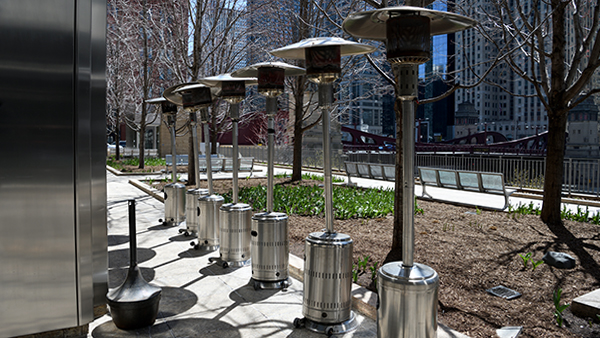
Patio heaters can extend seasonal use of outdoor spaces for homes and businesses.
Portable, outdoor gas-fired heaters – or patio heaters – are increasingly popular in cooler climates for use at home and in outdoor seating at restaurants. While the heaters offer comfort, using them involves potential risks.
Outdoor heaters are typically a free-standing pole with a reflector dome or shield and a base that stores a 20-pound propane (LP gas) cylinder.
Consider these do’s and don’ts when placing patio heaters:
Location and Placement
- Do set firmly on the ground and not on a slope; consider adding sandbags or other weights to the base to make the heater more stable.
- Do keep combustible decorations, awnings, sunshades or similar attachments more than 5 feet away.
- Do maintain at least 5 feet from any building and all areas of entry and exit.
- Don’t use indoors because of the risk of carbon monoxide poisoning.
- Don’t place on a balcony because of the risk of tipover and ignition of materials.
- Don’t use in strong winds.
You’ll also want to consider other safety factors regarding gas-fired heater designs and fuel use.
Design Features
- Inspect the heater and other components for damage prior to use. If you see signs of damage, do not use.
- Make sure the product is Underwriters Laboratories or Canadian Standards Association listed; UL/CSA markings tell you the product was tested to meet current safety standards.
- Confirm the heater has a tipover switch. This automatically shuts off the flow of gas if the heater is tilted more than 15 degrees from a vertical position.
- Assure the heating element has a guard to prevent accidental contact by people – especially children – or materials.
- Locate the emergency cutoff switch to shut off the gas flow quickly in case of emergency.
Fuel Containers
- Check that fuel gas containers are certified and approved by the Department of Transportation or American Society of Mechanical Engineers.
- Wait to replace the fuel containers when other people are not present.
- Store fuel containers outside of buildings, away from doors, stairways, windows and other means of egress.
A Note About Electric Heaters
- Do not use electric heaters in restaurant settings because the cords may present a tripping hazard. Smaller outdoor suspended electric heating units should be secured above restaurant tables and checked.
Many localities do not allow patio heaters. Consult your local fire department or city building authority for additional information, and always be sure to read the manufacturer’s directions and warnings specific to your model of patio heater.
This loss control information is advisory only. The authors assume no responsibility for management or control of loss control activities. Not all exposures are identified in this article. Contact your local, independent insurance agent for coverage advice and policy service.
